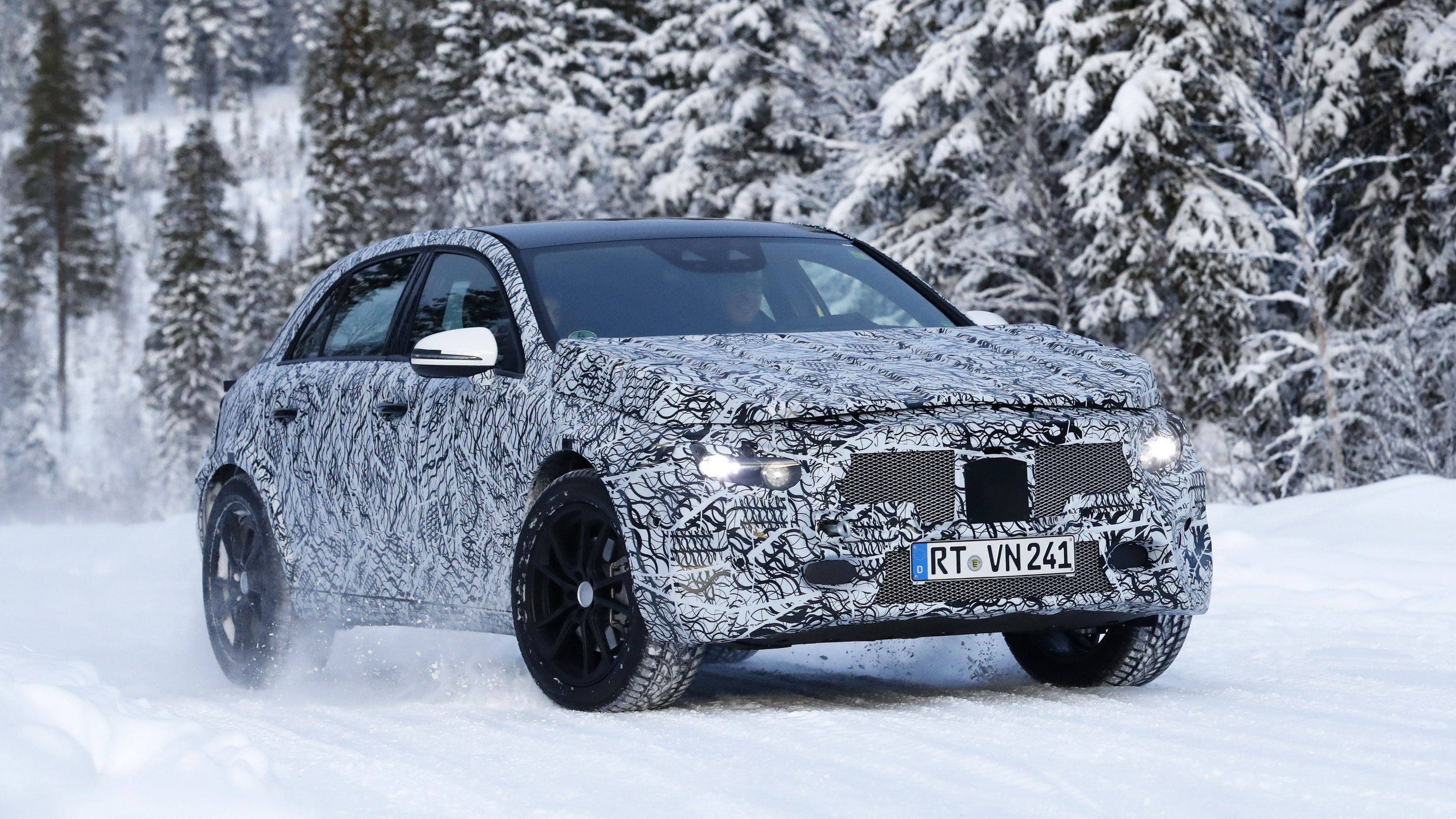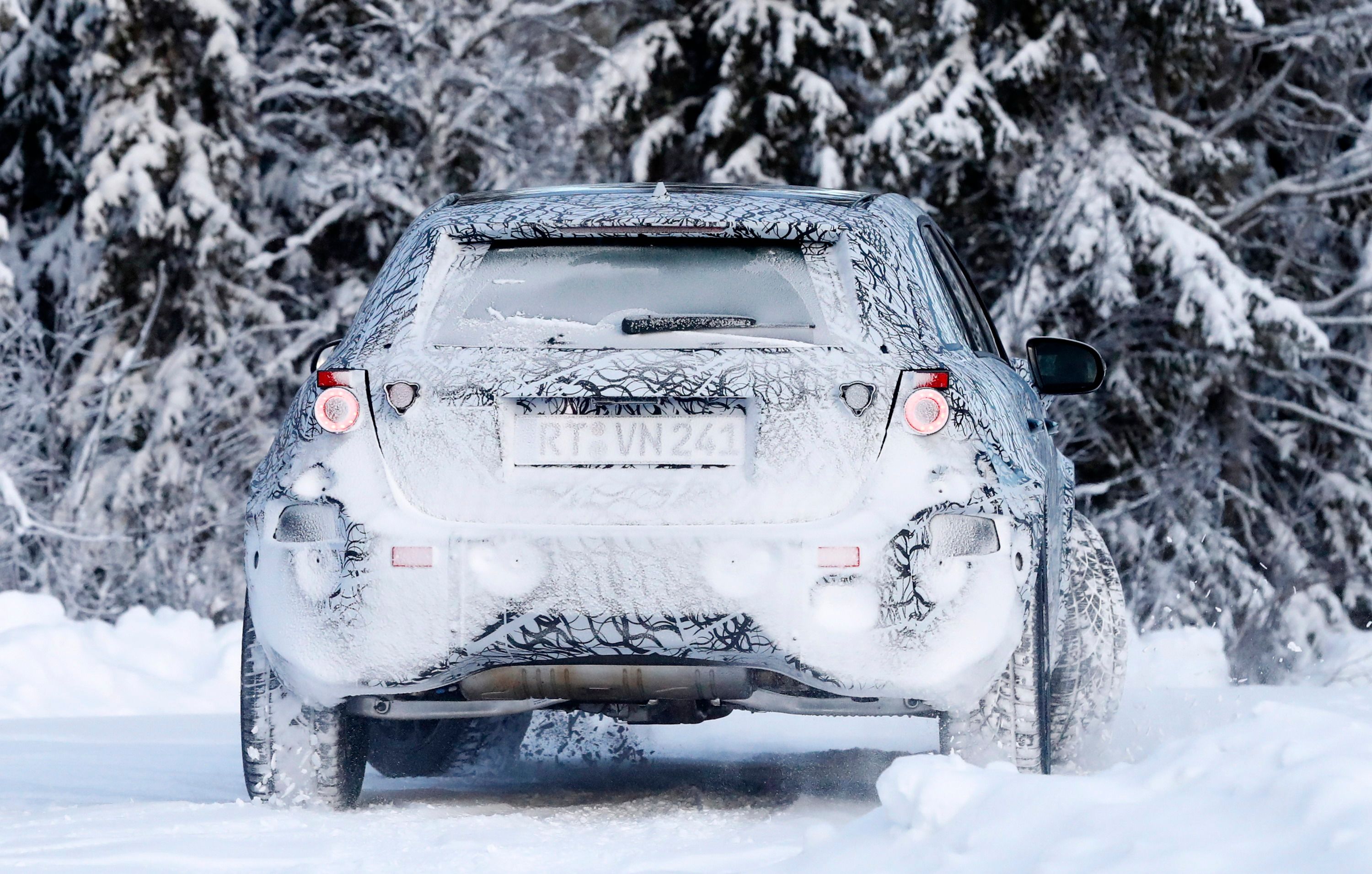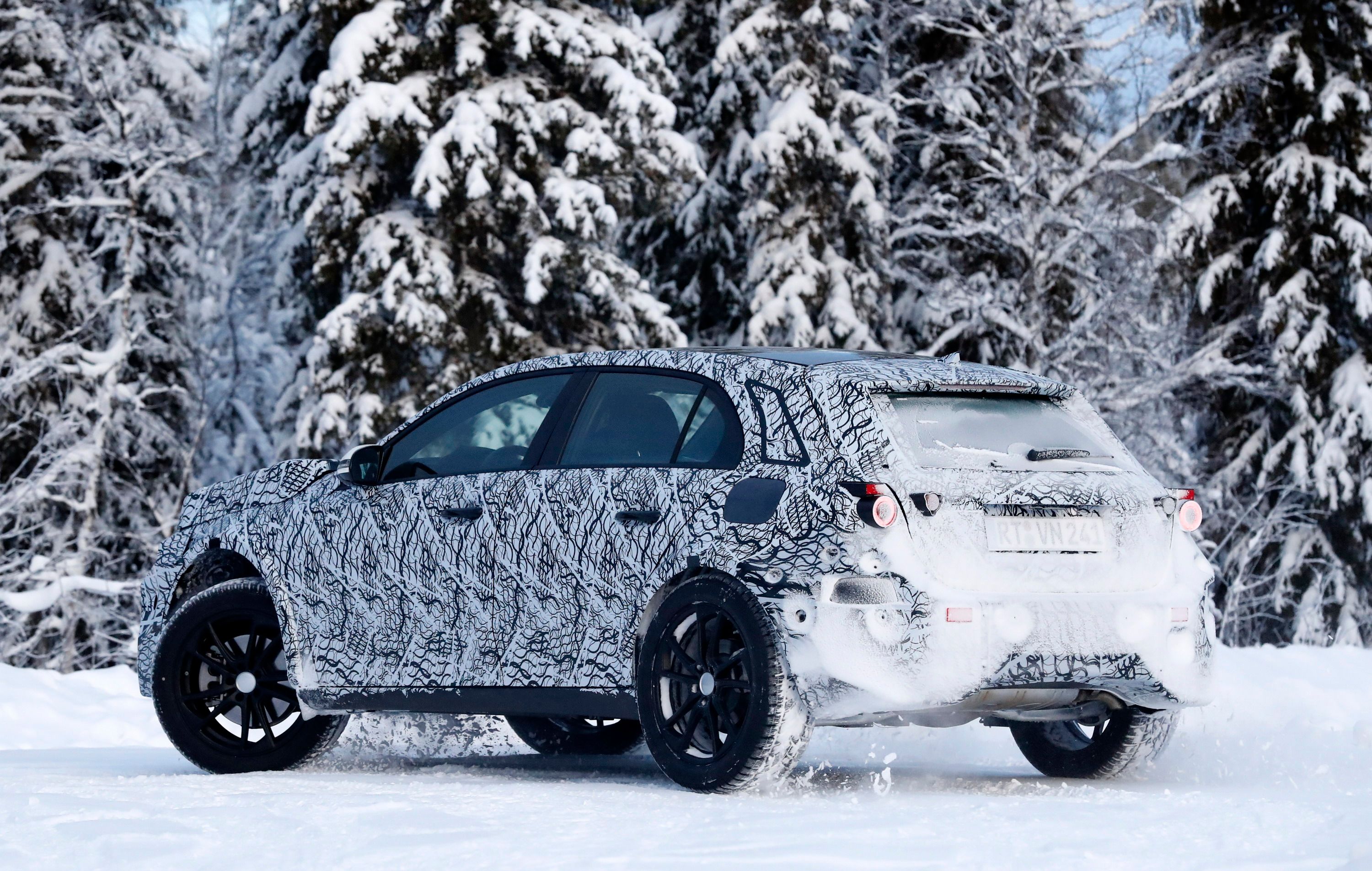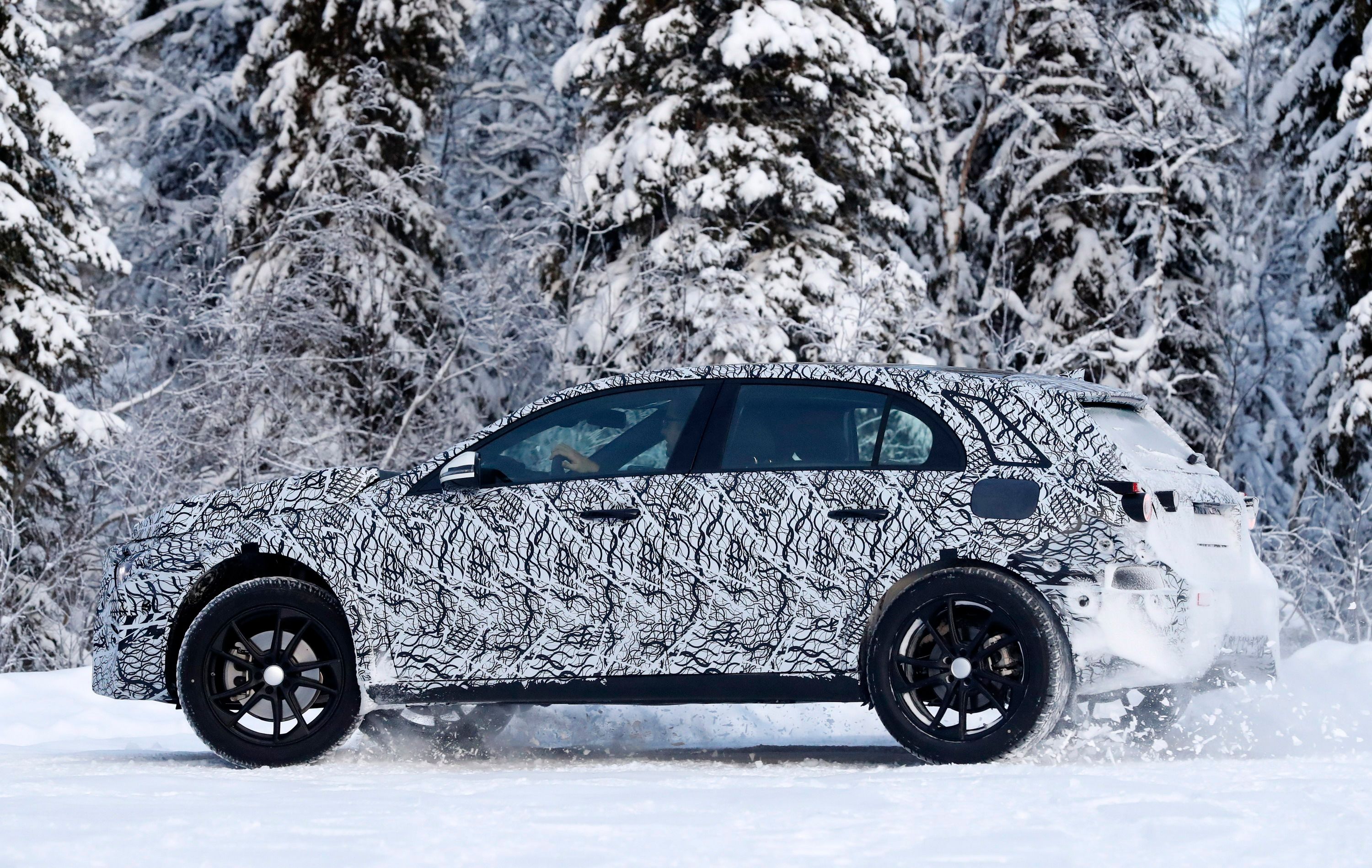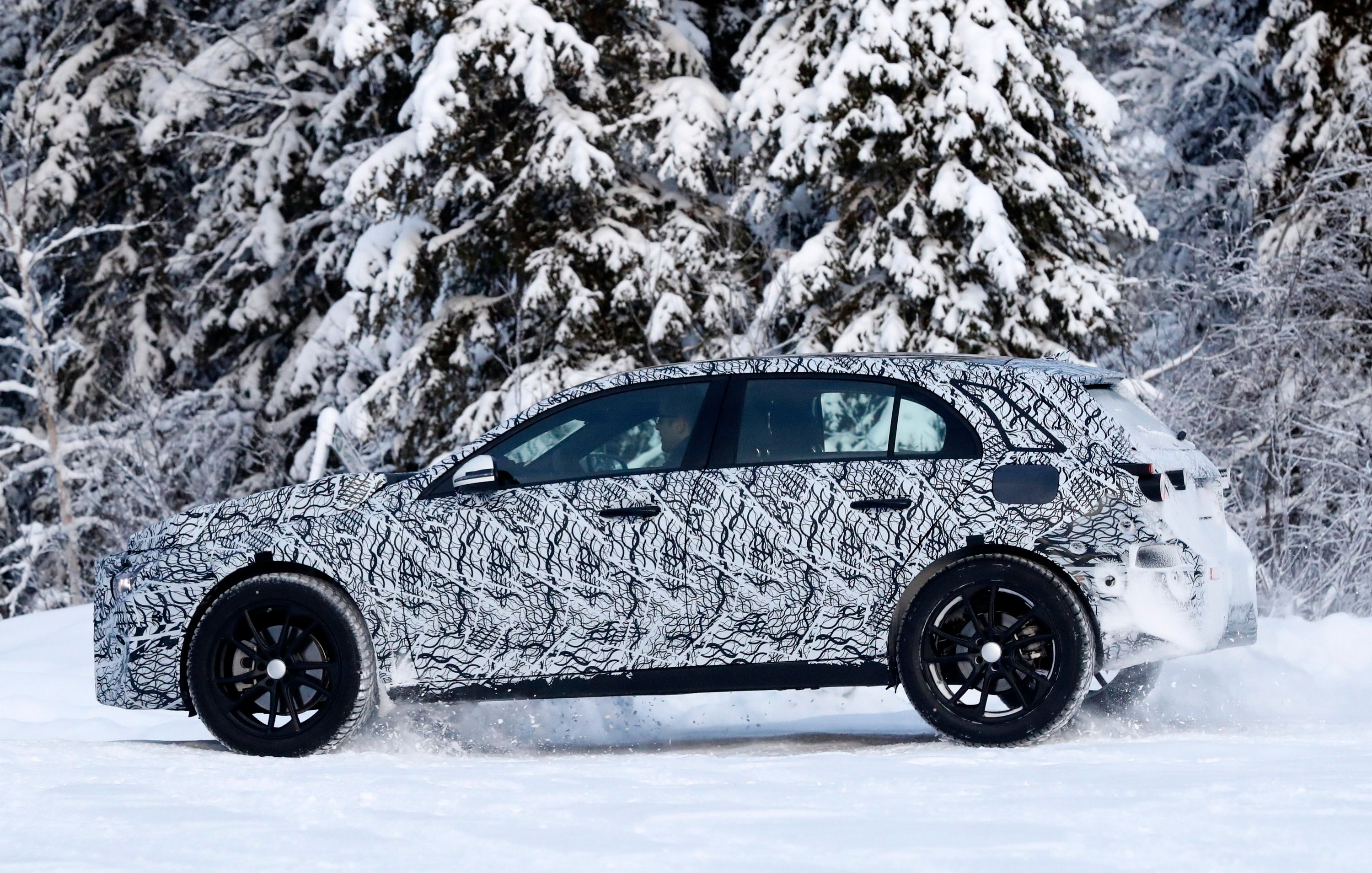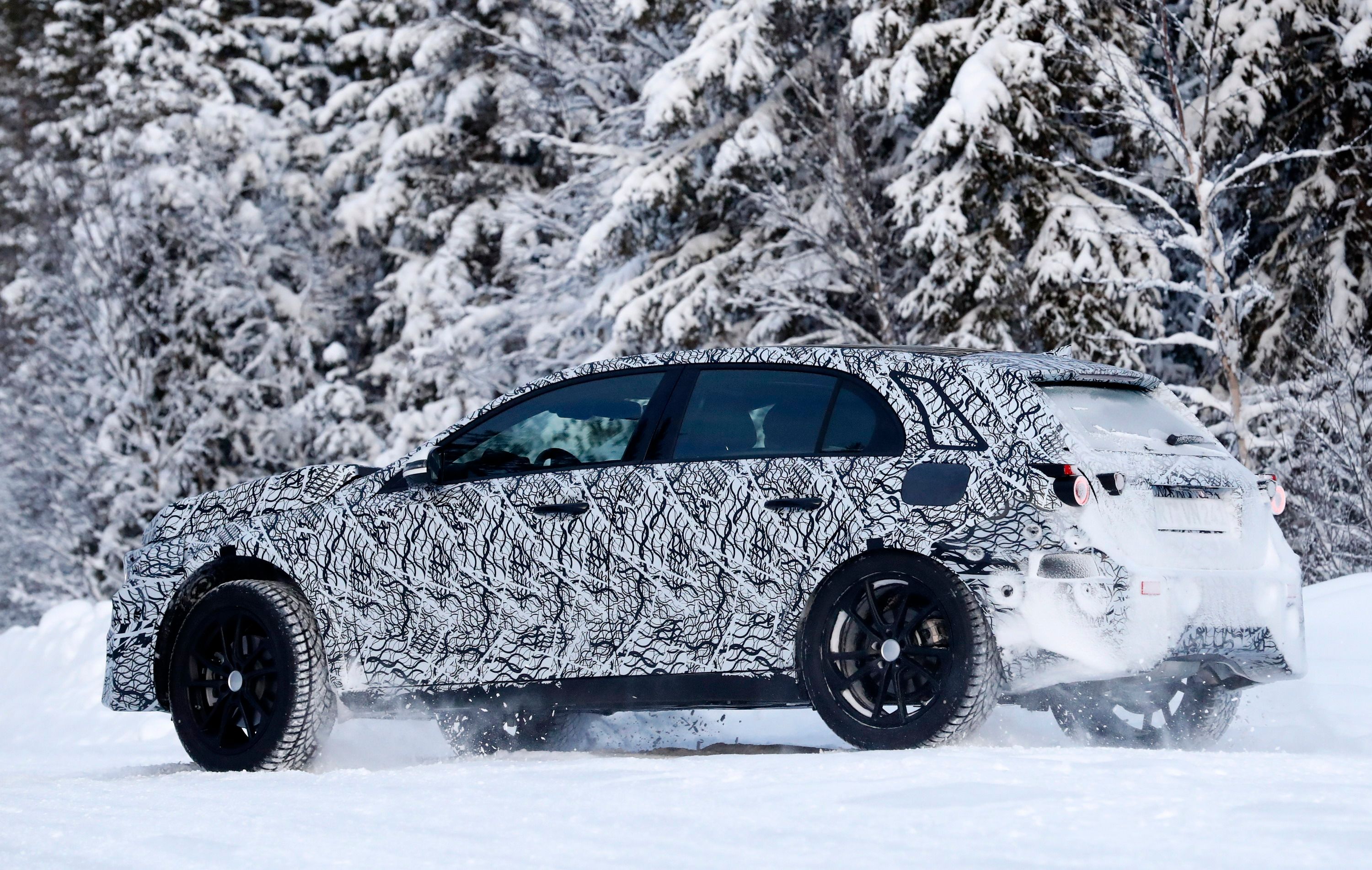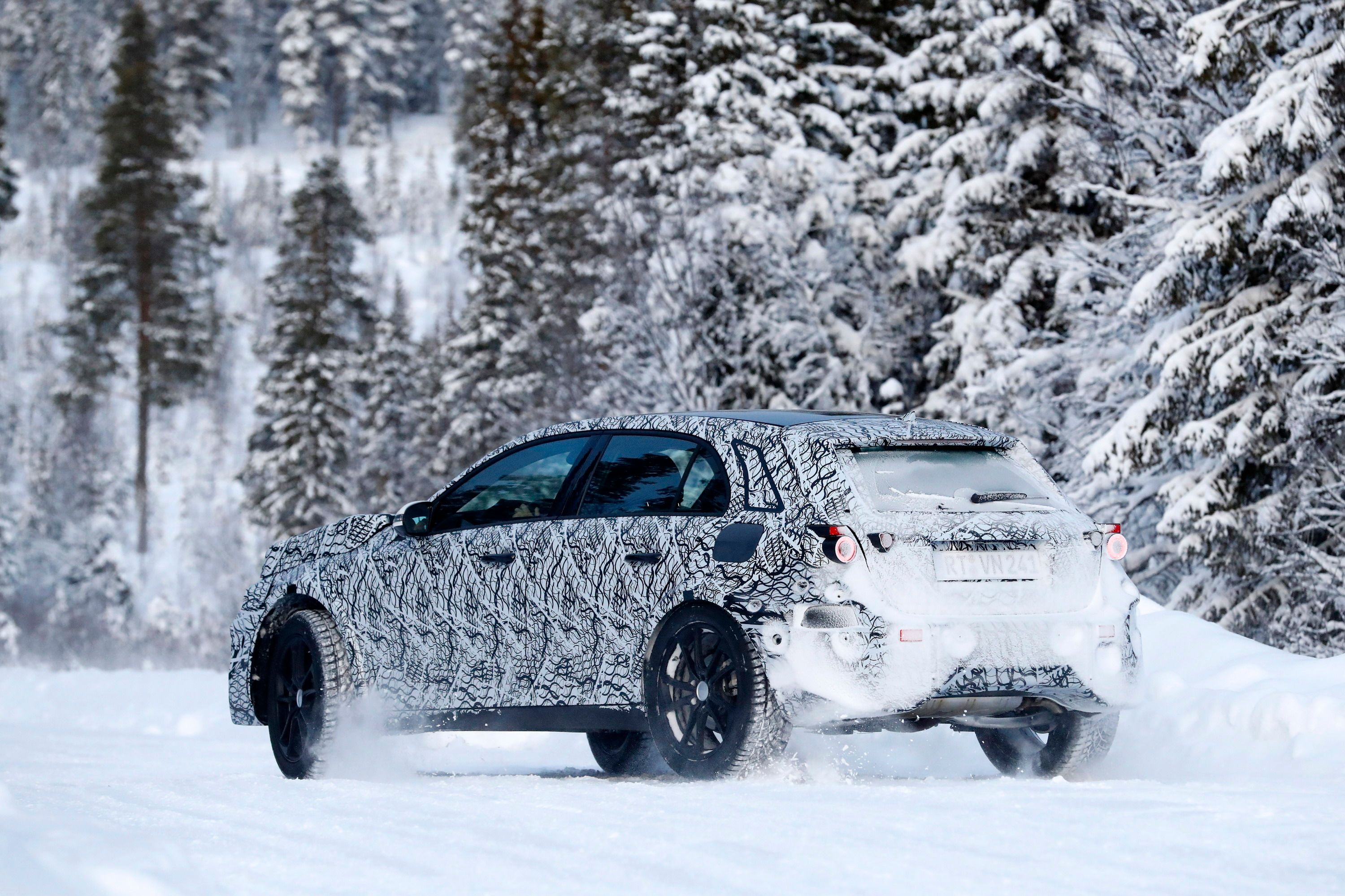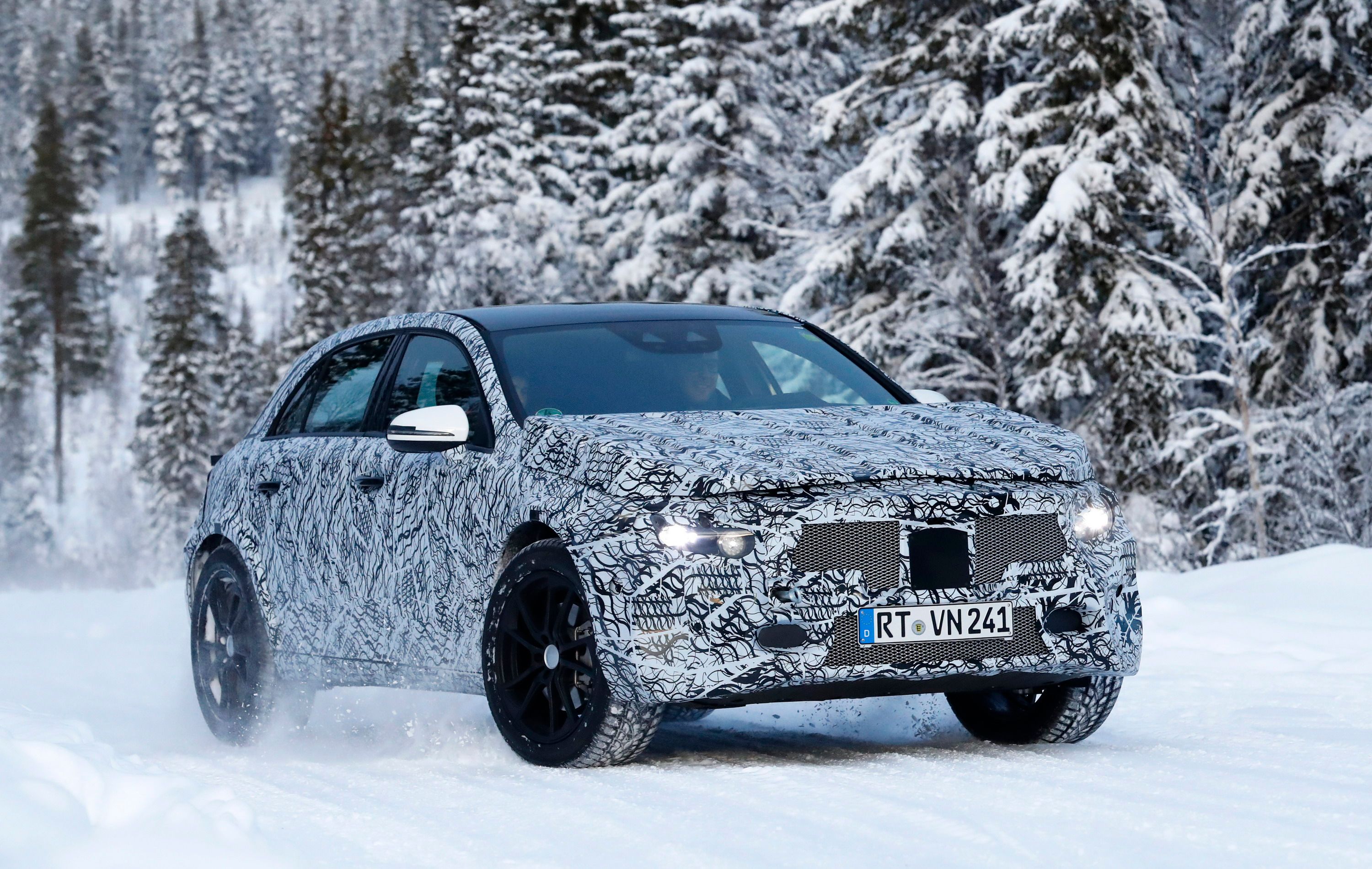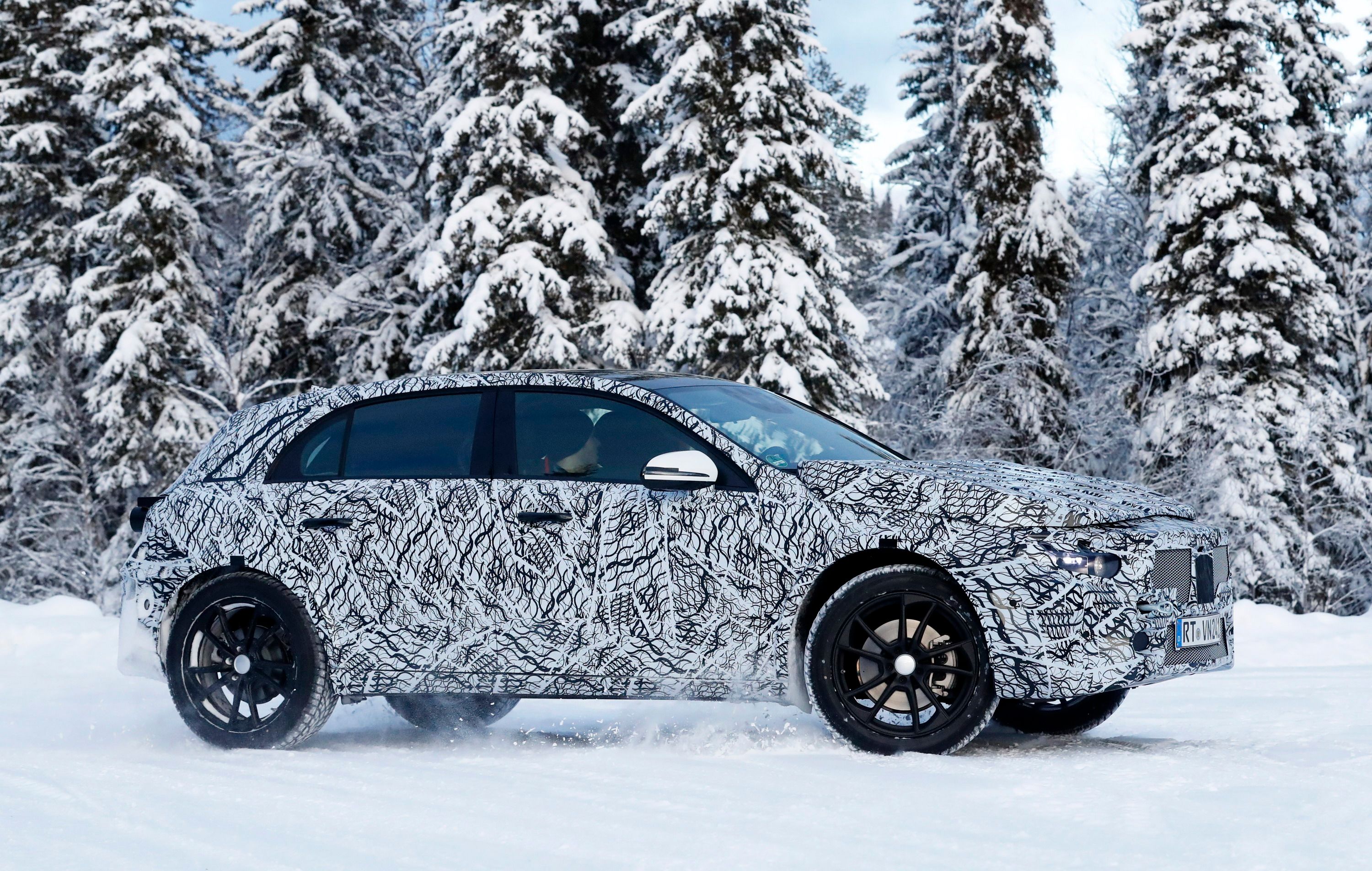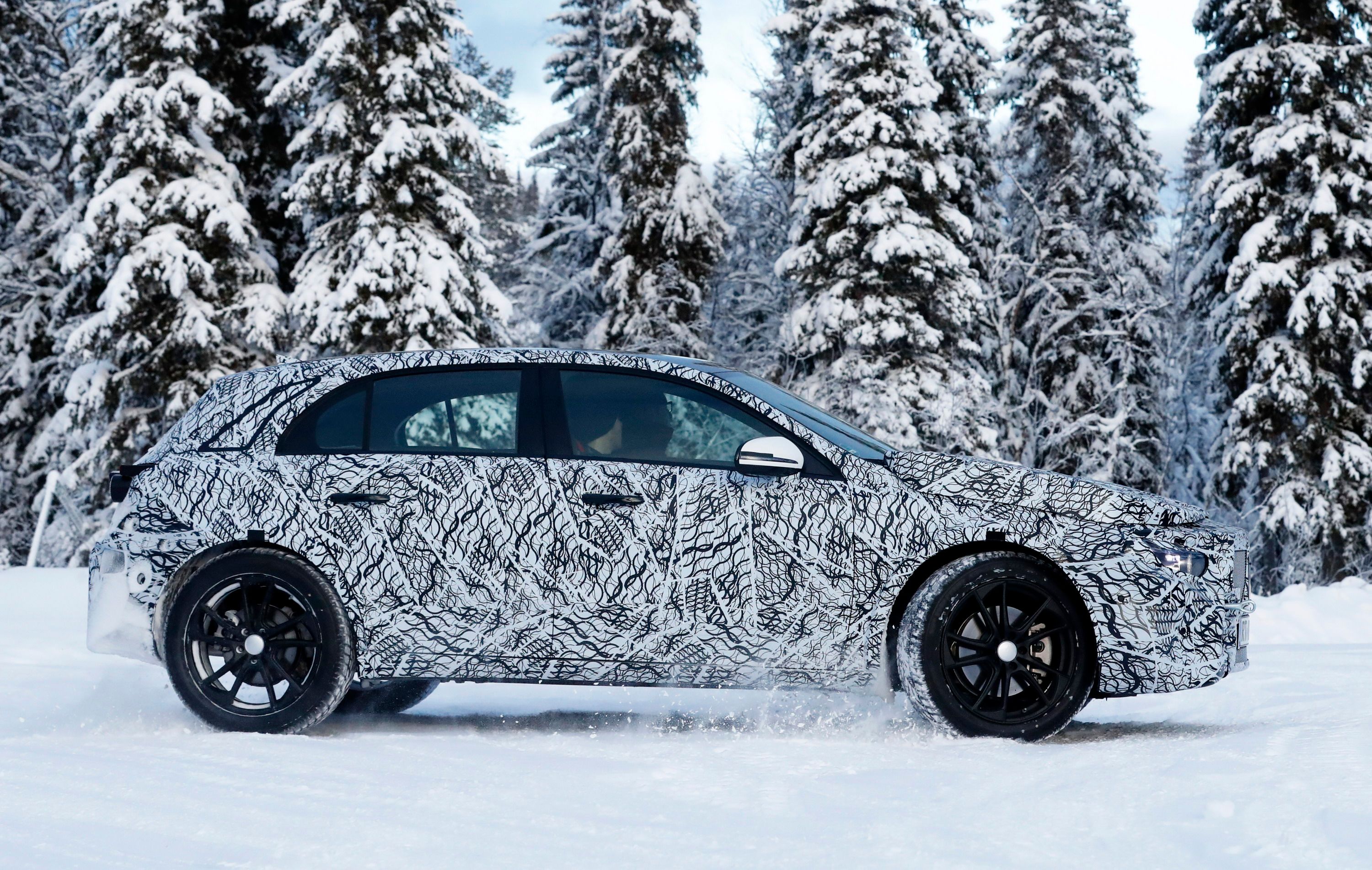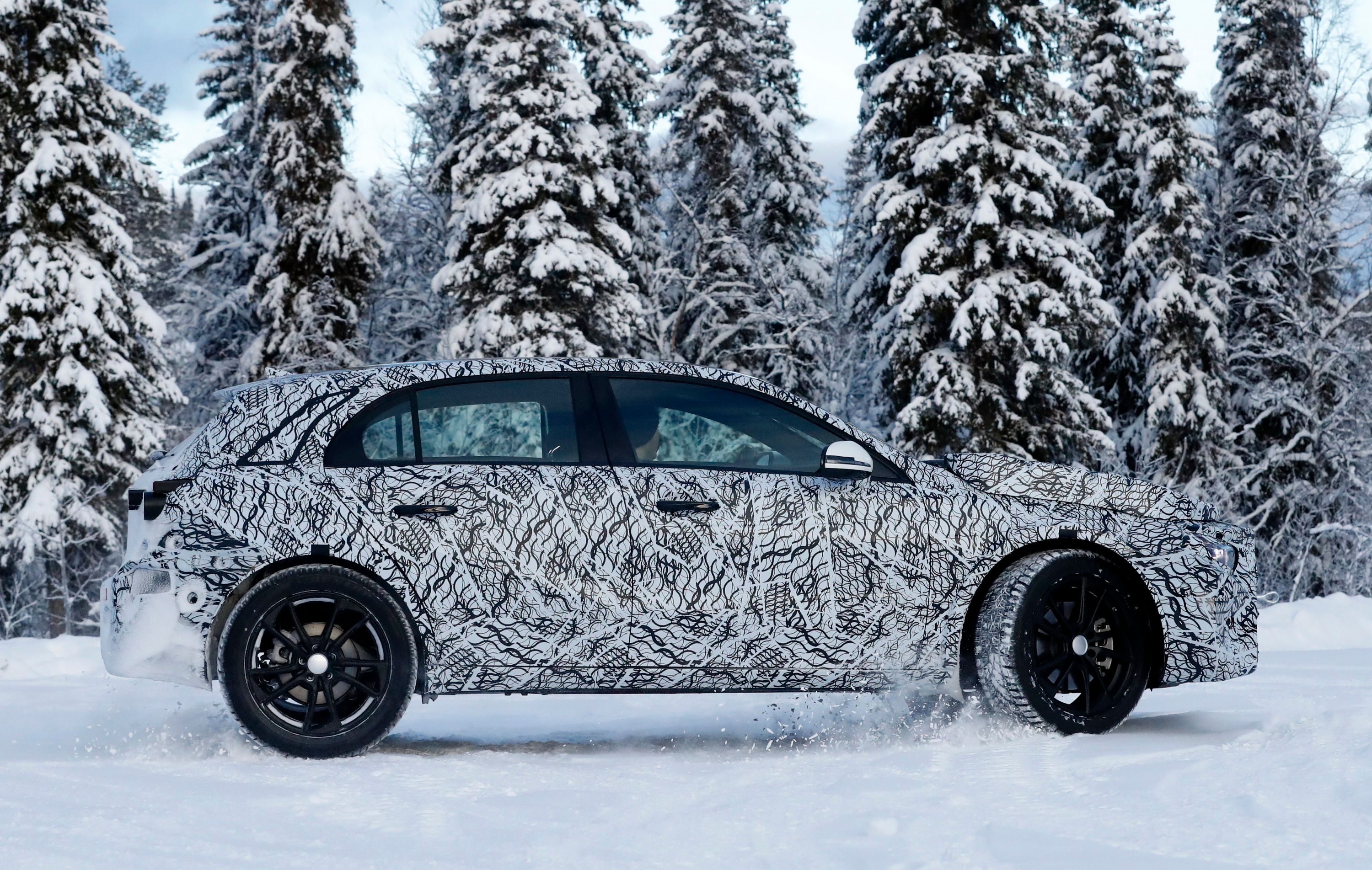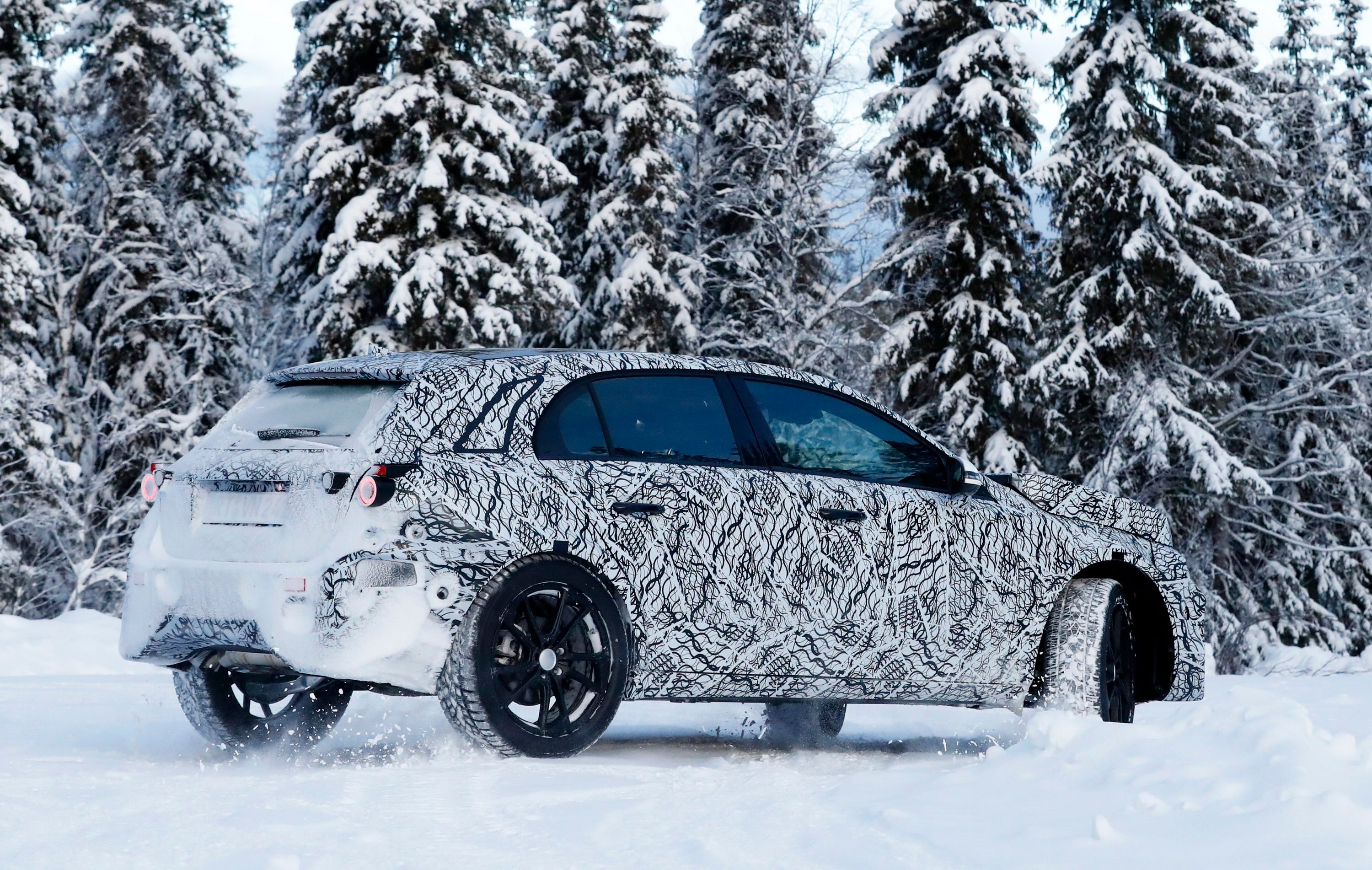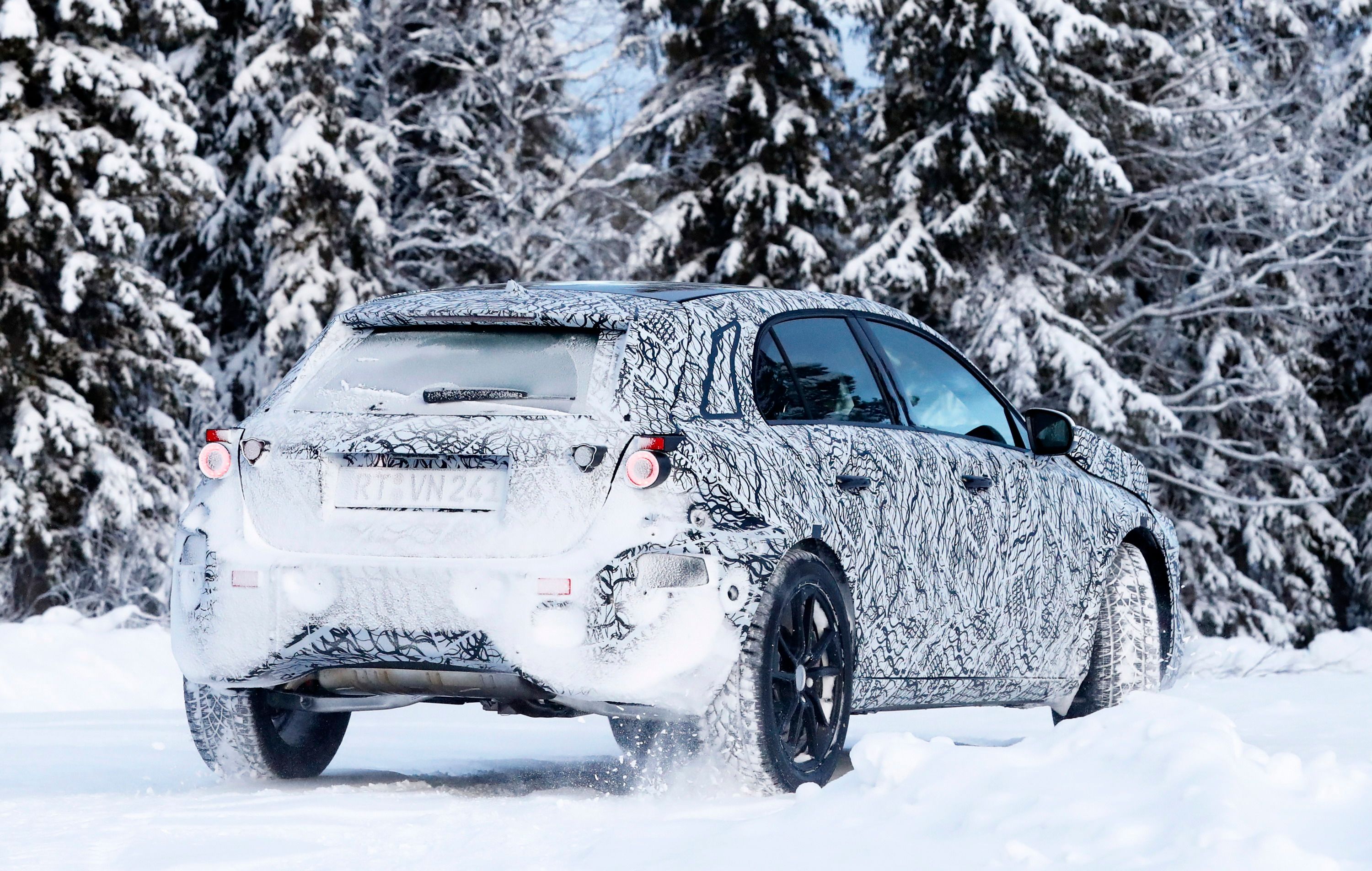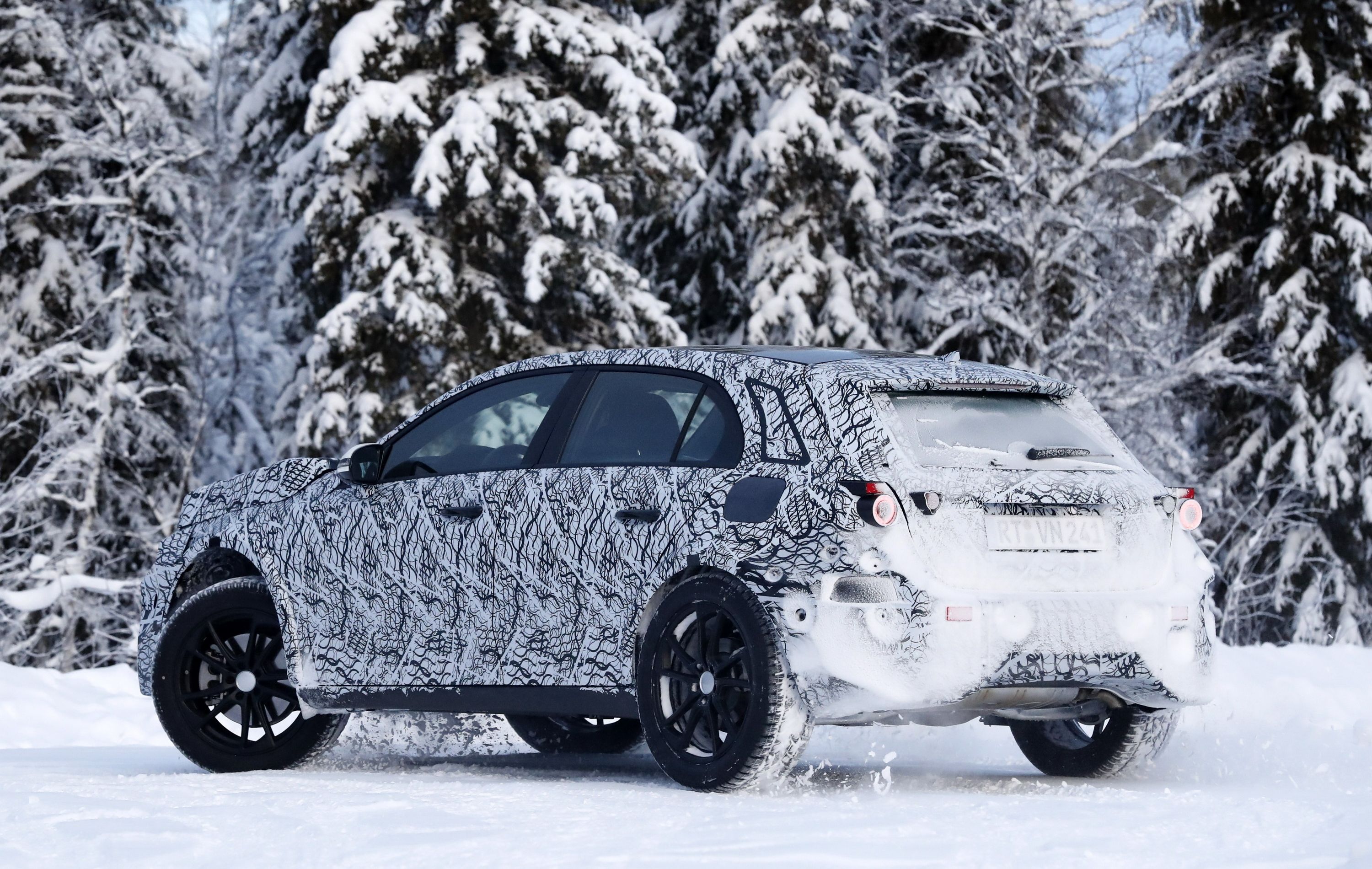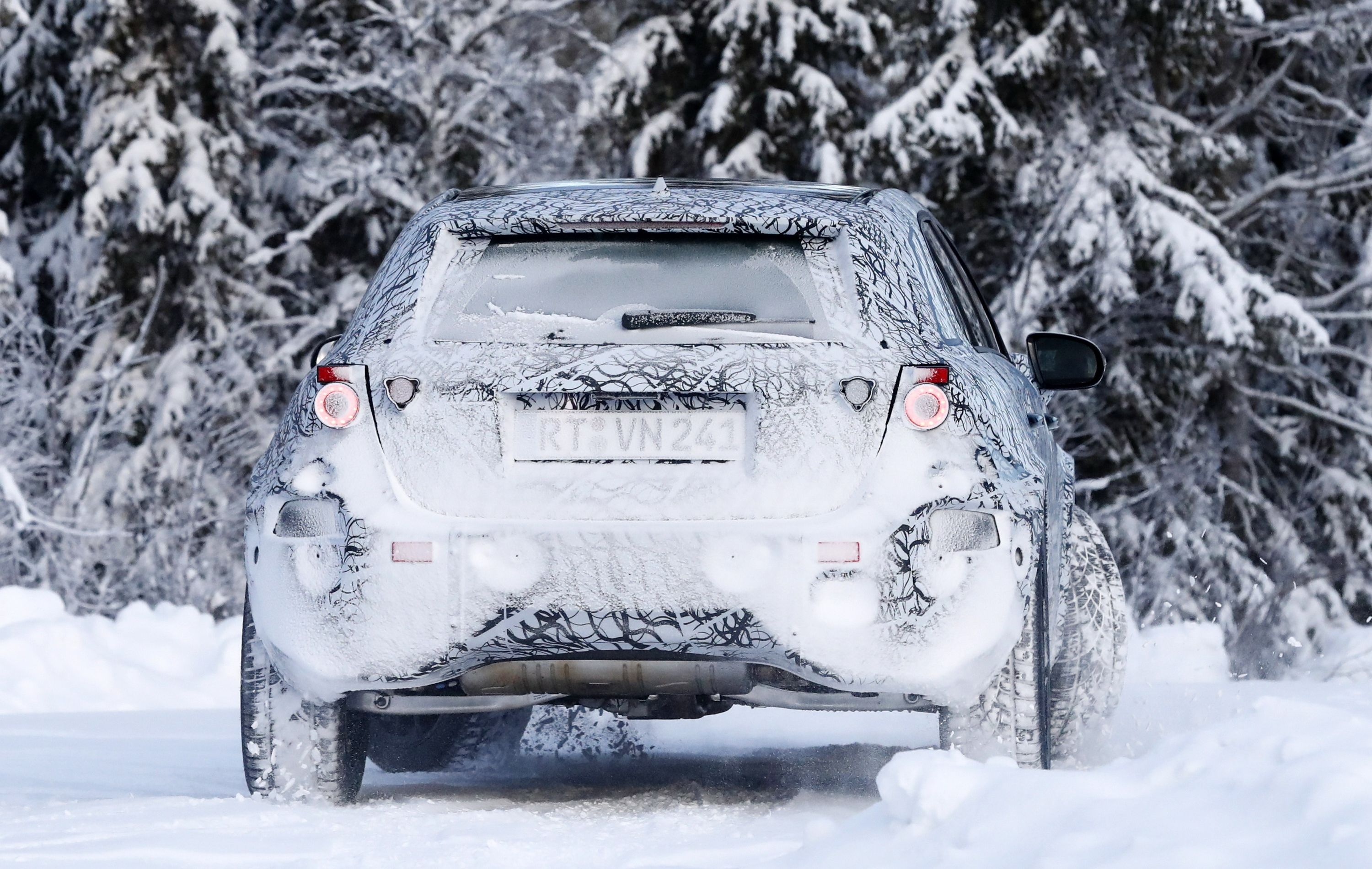The Mercedes GLA is the toddler of Mercedes lineup, with the first model being introduced as a concept at the 2013 Shanghai Auto Show with the production model following shortly after at the 2013 Frankfurt Motor Show as a 2014 model. With only three years on the market, Mercedes debuted a facelifted model at the 2017 Detroit Auto Show as a 2018 model, which will last until late 2019 when Mercedes is set to debut the crossover’s second generation. The order books for the facelifted, first-gen model haven’t even opened yet, and it’s clear that Mercedes isn’t wasting any time as we’re looking at a fresh set of photos that show an early example of the second-gen prototype getting its play on in the snow. This prototype is clearly in the embryonic stage of development and is covered in heavy camo all the way around, decoy lights in the front and rear, and some heavy padding, but that’s not enough to conceal the fact that the prototype has a slightly wider track and a little extra ride height. It’s also sporting bigger wheels than what’s offered as standard on the current GLA and should share its platform with the Mercedes A-Class.
There isn’t much else known about the upcoming, second-gen GLA but as is the case with the current A-Class and GLA-Class duo, it should carry a similar design to the next-gen A-Class and use a majority of the same engines and transmissions too. But, with its debut scheduled for late 2019 at the earliest, there’s still plenty of time for things to change. In the meantime, let’s take a good look at this first round of spy shots, talk about what we can see, and make a few predictions while we’re at it. Grab a hot cup of joe and join me a little farther down the page to get to it.
2020 Mercedes-Benz GLA
- Make: Array
- Model: 2020 Mercedes-Benz GLA
- [do not use] Vehicle Model: Array
Exterior
One of the major defining features of the current GLA-Class is the sharp and protrusive lines of the hood, with the outermost muscular lines feeding from the nose, across the hood, and into the A-pillars. It brings a bit of geometric instability to an otherwise well-rounded vehicle. As a signature of sorts for the model, it’s not likely that Mercedes will do away with this look altogether but, based on the extreme padding on the hood of this prototype, Mercedes is planning something new for the hood. It could be toned down a bit, or those muscular lines could be even more protrusive and uplifting. Based on how tall the hood padding is on the sides, my money is on them being more pronounced on the second-gen model, but we’ll see how that turns out sometime down the line. As far as the headlights go, we’re not sure if they are decoys or not, but they appear to be much smaller than those of the current model and look to be more recessed. If these are the next-gen lights, they’ll be shorter and positioned in a way that they wrap around onto the fenders a bit more than they do on the current model. There is no grille or air dam to speak of, and the fascia is far from being production-ready, but expect to see the air dam maintain its current width but grow a bit taller. A new fog light design will be showcased in the corners, but we won’t see that for some time to come.
Moving over to the side profile, there are a few things that we can point out. First, the roof has a slightly steeper slope to it, while the waistline is now flat instead of curving upward on the rear doors. The stationary glass on the rear door is now larger and rounded, taking on the quarter-circle look. There’s also a weird cutout in the camo on the upper rear quarter that could indicate the addition of a stationary window in the upper-rear quarter panel. Looking at the side, we can also see that the body is a bit longer than the current model (as shown by the space between the rear door and the rear hatch) and the rear-most edge of the door know wraps around the rear wheel well as opposed to following the contour and making up the front half of it. The rear door looks just a bit larger, which should make entry to the rear a little easier. The prototype does have more ground clearance that the A-Class, but the larger wheels and tires almost fill up the gap between the body and the tires. When the driver is really getting on it, you can see the rear squatting quite a bit and dramatically decreasing the body/tire clearance in the rear, indicating that Merc will probably make some adjustments to the rear suspension over the next couple of years.
Around back, there’s lots of padding and snow to block our view, to go along with a pair of decoy taillights. But, from what we can tell, the rear hatch will feature wider edges that wrap around the rear end more than before. The outside edges of the hatch will still have that weird inward curve at the taillights but should be smoother than that of the current model. It doesn’t appear as if that lip just below the rear glass is on this prototype, the lack of which would give the rear end a much smoother look. As is the case up front, the rear fascia is likely a decoy, or at the very least, missing its rear cladding insert that houses the rear exhaust outlets. Expect to the see production version rock a more defined rear fascia with new exhaust outlets and a more pronounced diffuser-like element.
Interior
For now, the interior is a major mystery. And, even if we did get some shots of the inside of this prototype, it probably wouldn’t give us too many hints as to what to expect anyway. Expect to see an all-new dash, redesigned steering wheel and instrument cluster, to go with a new seat design that could include diamond quilting in upper trim levels or, at the very least, in the AMG-branded models. The door trim panels will also get a full redesign while new color options and wood trim selections will be revealed closer to the car’s launch. As far as interior space goes, expect to see a decent increase in rear passenger space and cargo space thanks to the slightly longer and wider body. Rear headroom may drop a little due to the slightly steeper roof, but Mercedes could easily solve that problem by lowering the rear seats by an inch or so. The rear seats should fold flat into the floor for extra cargo room while needed. Up front, passengers should get just a tiny bit more hip and shoulder room, while headroom and legroom will probably remain the same.
Note: Current GLA interior shown here.
As far as technology goes, the infotainment display will be powered by updated software that will make that current system look as outdated as Windows 95 running on a Mac. Mercedes will probably keep the same floating display design above the center stack, but with advances in technology between now and then, that screen will probably be much thinner and could grow by an inch or two – after all, we are all about the bigger screens these days, right? The weird mouse controller that Mercedes has been using will probably be long gone by the time the production model debuts, so the infotainment system will be controlled by the touchscreen interface or a touchpad on the center console. Entry-level models may get a simple control knob while the touchpad will probably be an option.
AMG models will get healthy doses of Alcantara and carbon fiber appointments. They could also be offered with an all-digital instrument cluster to go with AMG branding in all the usual places. Several sound systems should be offered for all models, and there should be phone connectivity via Apple CarPlay and Android Auto. Furthermore, expect to see a 360-degree camera and the addition of new semi-autonomous features as well. For now, it’s all speculation, but with so much time before the car makes its debut, there’s plenty of time for Mercedes to come up with new ways to impress us with its smallest crossover.
Drivetrain
The upcoming GLA will share a platform with the A-Class, both of which are expected to ride on an updated version of the MFA architecture that is known as MFA2. This updated platform is a bit longer (hence the slightly longer body,) will be lighter, and will be able to support more drivetrain options than before. It’s still a bit too early on to say anything for certain, but expect to see the usual mix of small-displacement engines in both gasoline and diesel form. Some engines from the current lineup will be updated and carried over while there may be a new engine or two making their way onto ordering forms. The current U.S.-Spec GLA is only offered with one engine size here in the U.S. – a 2.0-liter. In the GLA250 and 250 4MATIC, it delivers 208 horsepower and 258 pound-feet. In the AMG GLA45, that 2.0-liter is handcrafted and tuned to deliver 375 ponies and 350 pound-feet of twist. Currently, there is no diesel option available in the U.S., and I wouldn’t expect that to change for the coming generation. For U.S.-Spec models, I suspect the 2.0-liter will carry over but will be updated to deliver more like 230 horsepower and 270 pound-feet in the 250 or upward of 385 ponies and 360 pound-feet in AMG form – you can’t expect Mercedes to squeeze much more out of a four-cylinder, so gains for the AMG version will be minimal at best.
Note: Current GLA engine shown here.
On the other side of the world, the GLA is available with a more attractive engine lineup that includes a 1.5-liter diesel, 2.1-liter diesel, a 1.6-liter gasoline unit, and a 2.0-liter gasoline unit. Chances are most of these engines will carry on with minor updates as well. The 1.5-liter diesel could be massaged to deliver a 5 horsepower increase, bringing total output up to 112 horsepower and 195 pound-feet while the 2.1-liter diesel could deliver as much as 150 horsepower (an increase of 16 ponies) and as much as 235 pound-feet of torque (a 15 pound-foot increase.) The 1.6-liter gasoline engine could see a 10-horsepower increase to bring it up to 130 horsepower, with torque output increased by 8 pound-feet up to 155 pound-feet of twist. The non-AMG 2.0-liter models could see horsepower jump up to around 220 horsepower with torque pushing 270 pound-feet while the AMG models will likely see an increase to 385 horses and 360 pound-feet, just like here in the U.S.
All U.S. models should be offered with 4Matic all-wheel drive while the entry-level models in non-U.S. markets will only be available with front-wheel drive. On the transmission front, the six-speed manual transmission will carry over, and the seven-speed automatic found in non-AMG models should get updated programming and materials. The AMG models will see updates to the Speedshift dual-clutch that will help improve shift times and reliability even more.
Pricing
At this point, we’re still at least two years out on the production model, if not more, so there’s no telling what kind of pricing changes we’ll see with the new generation. The current model here in the U.S. starts out at $32,850 and goes up to $34,850 if you want the 4Matic all-wheel-drive system. The Mercedes-AMG GLA45 starts out at $49,900. Pricing will likely increase a bit, so expect the entry-level model to start out at $33,500 while the AMG model will command somewhere around $50,700.
Competition
BMW X3
The BMW X3 has been around since 2003, so it’s not exactly a spring chicken, but is being redesigned for the 2018 model year, so it is soon to get a fresh design. By the time the new GLA hits the market, the X3 should be in its final death throws before it’s mid-cycle update, but until then, it will continue with its fairly sporty but reserved design. Right now, it can be had with a 2.0-liter that delivers 240 horsepower, a 3.0-liter six-cylinder that’s good for 300 horsepower, or a four-cylinder diesel that pumps out a fair 180 horsepower. For the third-generation, there’s no word on any major updates planned for the drivetrain department, but each of the current engines could be massaged to deliver just a little more power. The current X3 is priced at $39,250 in s Drive 28i form and $41,250 in x Drive 28i form. The range-topping x Drive 35i commands at least $47,950 before options, taxes, and delivery charges. Pricing for the next-gen model is expected to increase a bit, but not so much that it won’t maintain its competitiveness on the market.
Read our full review here.
Read our full review here.0
The Audi Q3 is a fairly new model in Audi’s lineup, being introduced to some parts of the world back in 2001. But, it didn’t come to the U.S. market until 2015, after Audi gave it its first facelifted. For 2017, the Q3 got yet another facelift that brought about some aesthetic enhancements inside and out, but a new model is expected for 2019, probably right before the new GLA will make its debut. Currently, the Q3 is available in the U.S. in three different trim levels, all of which can only be had with a 2.0-liter, gasoline-drinking, four-cylinder. It delivers 200 horsepower and 207 pound-feet of torque, the latter of which is available as low as 1,700 rpm. It offers the comfort and luxury expected from the big German three, with technology that is in line with other models in this segment. Pricing for the model that will be on sale when the second-gen GLA hits showrooms is a complete mystery, but don’t expect it to command much more than the current model at $31,800 in entry-level form, $34,500 in Premium Plus form, and $39,200 in Prestige form.
Read our full review here.
Infiniti QX30
Infiniti introduced the QX30 to the market for the 2017 model year as an elevated version of the Q30 that’s ready to tackle rougher terrain and make the SUV-loving masses happy. Being so new on the market means that the GLA will hit showrooms before the QX30 gets its first mid-cycle update but given its current design, that’s not exactly a bad thing. It offers a sleek and sexy design outside, with comfortable materials and top-notch technology on the inside. Here in the U.S., the QX30 is available with just one engine – a 2.0-liter four-cylinder that delivers 208 horsepower and 259 pound-feet of torque. That engine comes mated to a seven-speed, dual-clutch transmission. All-wheel drive is available on the QX30, but you’ll have to purchase the Luxury AWD or Premium AWD trim; all other trim levels are available as front-wheel drive only. The QX30 starts out lower than all of the models we’ve discussed thus far at a fine $29,950 and increases to as much as $38,500 for the range-topping QX30 Sport. For the record, that’s a range-topping model for less than the entry-level BMW X3, so let that sink in for a minute. Furthermore, since we’re offering this as a competing model for the GLA, I should point out that Q30 does sport some Mercedes DNA, including that 2.0-liter four-cylinder.
Read our full review here.
Conclusion
Mercedes still has at least a couple of years on the calendar before the next-gen GLA will roll onto the scene, but the fact that it’s already out doing some initial testing hints to the possibility of significant changes to the chassis, driveline, or even a new engine. We’ll probably see at least two more testing sessions before the production model is teased, so there’s still lots of changes to talk about in the future. Until then, you can check out our gallery of the current shots and let us know what you think about what you see so far in the comments section below. With that said, stay tuned for updates.

